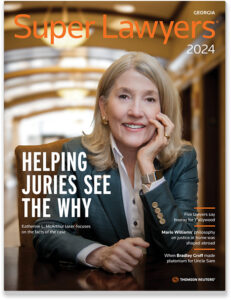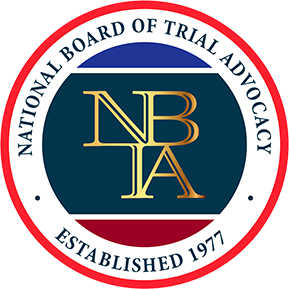original story by Katie Wood of the Daily Report
Along the way to winning a $19 million verdict, the Macon lawyers representing the paralyzed and brain damaged victim of an exploding tire rim rejected a $7.5 million settlement offer.
The defense proposal came after a federal jury in Lexington, Ky., determined that neither plaintiff Danny Webb nor his employer had caused the explosion, thus clearing the way for the damages phase of the bifurcated trial.
“At that point, with the liability already sealed, we were prepared to deal with the verdict,” says Katherine L. McArthur who, along with fellow Reynolds & McArthur principal W. Carl Reynolds, represents Webb.
The gamble paid off Wednesday, with the return of an award for $19,098,721, including $8 million in punitive damages against one of the three defendants in the case, Firestone Tire & Rubber Co. Webb, 30, received $10,340,620 in compensatory damages. Webb’s former employer, the Hargett Corp., was awarded $758,101 to reimburse it for workers’ compensation benefits paid prior to trial.
Reynolds refused to discuss his firm’s contingency fee arrangement with Webb, but said the cost of carrying the case will probably exceed $130,000.
The accident occurred Sept. 4, 1985, when Webb, a Hargett laborer, noticed that a tire was low on the 1968 Chevrolet dump truck he was driving. Webb pulled into a Sunoco station to use its air compressor. As Webb knelt beside the left rear tire and added air, the wheel on which the tire was mounted exploded, hitting Webb in the face and leg with such force that it knocked him backwards 10 feet in the air, according to Reynolds. T
he plaintiff’s lawyer adds, as a result of the near-fatal injuries, Webb is brain-damaged, paralyzed, partially blind and disfigured. A scar runs the length of the left side of his face. He suffers speech and memory impairment, has lost the use of both legs and his left arm, has only limited use of his right arm and has diminished sight in one eye. The dump truck was equipped with an RH-5 multipiece wheel co-designed by the Firestone Tire & Rubber Co. and Kelsey-Hayes Corp.
The ring was manufactured and sold by Firestone, and the base to which it was attached was manufactured and sold by KelseyHayes. It was assembled onto the truck manufactured by General Motors. Thinking that Webb would be staying at a health care facility in the Atlanta area, his lawyers initially filed against all three of those companies in Fulton Superior Court. Webb v. Firestone Tire & Rubber Co., No. D-33350 (Fult. Super. filed July 21, 1986). (That suit originally included a fourth defendant that was dismissed after it was determined it had nothing to do with the manufacture of the rim.)
But Webb eventually was moved to a Kentucky nursing home, and the case was removed to the U.S. District Court for the Eastern District of Kentucky, Lexington Division. Webb v. Firestone Tire & Rubber Co., No. 87-217.
Under Kentucky law, the employer and workers’ compensation carrier are entitled to recover payments from a third party found responsible for injury to a worker. Webb’s employer, Hargett, intervened in his suit to recover the expenses it paid him after the accident. Webb’s lawyers maintained that the tire rim had a design defect. They contend the three defendants not only knew of the defect, but also failed to warn consumers.
The problem with the RH-5 wheel, the plaintiff’s lawyers say, is that it tends to blow apart unexpectedly, whether the parts are new or old or whether or not they had been maintained. Reynolds says it is impossible to tell by looking at the wheel whether it is cocked to blow apart.
“It is just the most dangerous of all rims ever made,” asserts Reynolds, who says there are about 10 different types of multipart rims.
He says the RH-5 is responsible for about one-half of all exploding tire rim accidents. Limited by U.S. District Judge Karl S. Forester to introducing evidence of explosions similar to that Webb experienced while inflating a tire, the plaintiff’s lawyers say they showed that Katherine L. McArthur and W. Carl Reynolds rejected a $7.5 million settlement offer before the damages phase of the trial.
Firestone knew of 76 explosions, Kelsey-Hayes knew of 33 and General Motors knew of 21. The liability portion of the trial lasted four weeks, and by the time it was over the jury rejected defense arguments that Webb and his employer contributed to the accident by poorly maintaining the wheel. After 6½ hours of deliberation, the jury determined that Firestone should pay 65 percent of the award, that General Motors should pay 25 percent and that Kelsey-Hayes must pay 10 percent.
The jury deliberated five hours reaching the damages verdict, which made the punitive award only against Firestone. Firestone plans to appeal the verdict, according to one member of the defense team, David Schaffner of Amerman, Burt & Jones in Canton, Ohio. Joseph J. Feltes and David T. Moss of Amerman, Burt also represented Firestone as did D.G. Lynn of Hays, Moss and Lynn in Lexington, Ky.
“We will appeal both the apportionment and the total damages,” says Schaffner.
The other defendants are still deciding their next step. Lanny B. Bridgers of King & Spalding-who represented General Motors along with King & Spalding’s Steven J. Estep and Will H. Fulton of Woodward, Hobson & Fulton in Louisville, Ky.-referred inquiries about the case to the company’s headquarters.
“We’re reviewing the case and we’re considering an appeal,” says David E. Sloan, a spokesman for General Motors in Detroit. W.R. Patterson Jr., the Louisville lawyer who represents Kelsey-Hayes, also is pondering an appeal.
Hargett was represented by Pierce W. Hamblin and Stephen R. Chappell of Landrum & Shouse in Lexington.







